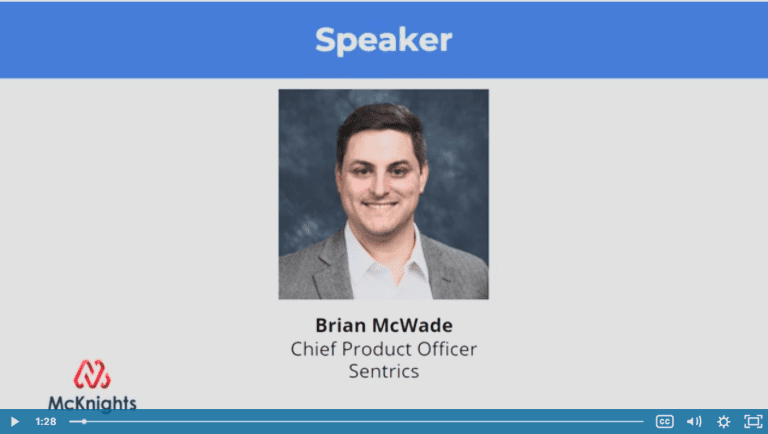Making data actionable for senior living improves health and wellbeing of residents.
Senior care in the United States has evolved dramatically in the last century. In the past, the main deliverable of a senior living community was hospitality for aging adults. Today, the assisted living industry is evolving to provide comprehensive, holistic, risk-based care to capture more of the healthcare revenue.
To make this happen, senior living communities must become fully integrated care facilities that provide tailored attention and proactive intervention, in addition to comfortable, engaging accommodations. This requires a seamless and non-invasive weave of modern technology into the fabric of senior living facilities, using proactive, high-tech, high-touch tools.
Moving from Hospitality to Risk-Based Care Requires a Commitment to Smart Technology
Senior living communities are becoming more reliant on integrated, data-driven solutions to help them better serve senior living residents and their loved ones. While these solutions are very sophisticated and highly technical, they are delivered in a personalized manner. The result is higher engagement, improved resident care, and better outcomes. Assisted living technology has proven successful for several communities that have comprehensively adopted a technology mindset.
- Benchmark Senior Living combines wearables and engagement to improve care.
- Juniper Communities leverages EMR to provide senior living residents an integrated “medical concierge.”
- Masonic Homes incorporates technology to support seniors in its communities.
- Good Samaritan Society uses predictive analytics to interpret resident sensor data.
Fully integrated, data-driven solutions are shaping the senior care industry. And these communities are succeeding because they have adopted senior living technology successfully. Assisted and independent living communities that want to survive and thrive, need to get there quickly. Senior living communities must embrace and adopt technology to compete.
Data Utilization Beyond Database Management
Technology has been an aspect of healthcare since the 1960s when computers first stored patient data. The evolution of health information management means that the collection of big data sets is now ubiquitous for the senior living industry.
An assisted living resident’s complete medical history is stored in an EMR, ambient sensors collect information about a resident’s surroundings, activity sensors collect information about a resident’s movement, and wearables keep tabs on a resident’s vital signs. Unquestionably, the data collected by these devices at an assisted living facility is key to better understanding resident needs and providing more personalized care. But collecting and storing big data isn’t enough.
The information contained in rows of data stored in a traditional relational database has no meaning on its own for a senior housing facility. It has no real value if it requires interpretation. The data must be mined continuously to be truly effective. It must provide actionable insight.
To gain those insights, senior living communities need to leverage artificial intelligence and machine learning. The data they collect must be analyzed using a platform that considers the conditional statement, “if this then that.” Such a platform identifies trends and provides caregivers in senior housing the ability to minimize episodes or prevent them from ever happening in the first place.
For example, if a resident starts using the bathroom much more frequently than in the past, the real time location system will send a UTI alert to the caregiver within the assisted living community.
This proactive approach to care is not the result of simple database management. Actionable insights only come from algorithms that identify patterns, learn from the data analyzed, make determinations or predictions, and then signal alerts to caregivers when something appears to be out of place. This is only possible by analyzing very big data sets from multiple sources that validate each other.
Sophisticated Data Analysis Creates Opportunities
Senior living can learn from companies in nearly every industry that already use big data analytics. The majority of them (66.7%) say that cost reduction was their initial motivation. Yet, more than half expect it to help them increase revenue. The reason? Its ability to predict outcomes. This helps companies increase productivity and make better, faster decisions in a constantly changing environment (Source: HostingTribunal.com).
The corollary for senior living communities is a predictive model that can quickly identify opportunities to minimize risks and improve assisted living resident care.
Within a holistic technology ecosystem that analyzes data collected from EMRs, sensors, wearables, and location tracking devices, proactive alerts can be routed directly to the smartphone of the caregiver closest to the resident within the assisted living facility, who can intervene and determine appropriate action. This new technology helps caregivers anticipate residents’ needs. It creates an opportunity for better care.
Leveraging Technology Increases Positive Outcomes
Big data analytics can help a community improve the quality of life of their senior living residents. Predictive analytics creates more positive engagement with seniors because it decreases adverse events. This improves all aspects of resident healthcare and overall daily living. The results are improved resident experience, reduced strain on community resources, and longer stays.
This is how progressive senior living communities are making data actionable to improve the welfare of seniors.



